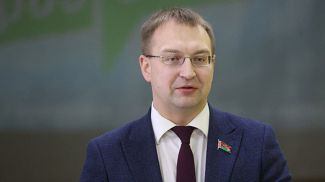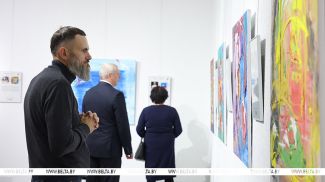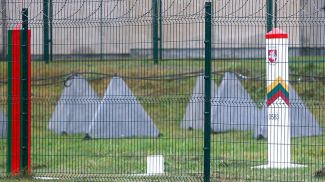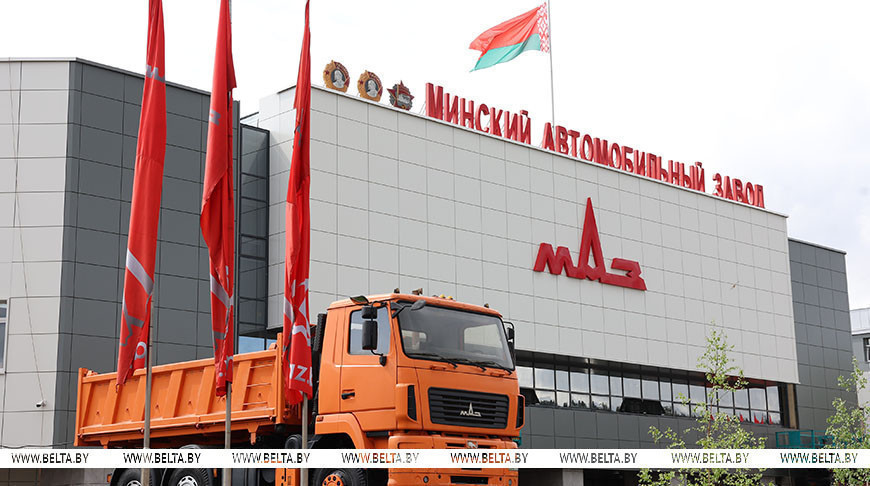
Several years ago, the Belarusian automaker MAZ decided to overhaul its bus production with a view to expanding capacities and creating new high-tech jobs. In 2023, the enterprise launched the construction of a new plant which combined several production sites. Today it resembles an aircraft factory rather than a classic assembly line. The thing is that bus production is sophisticated and largely manual work. In early 2025, Belarusian President Aleksandr Lukashenko got familiar with the reconstruction process at the enterprise to see how ready the production facilities and specialists were to start operation. On 31 March 2025, the first bus - the latest generation model – rolled off the production line. It seems a good reason for a visit to the plant.
Backstory
In the mid-1990s and early 2000s, Belarus set a course to save its industrial giants. The decision was taken to preserve the enterprises inherited after the collapse of the Soviet Union and to increase the competencies. Sometimes the Belarusian authorities were criticized for the priority given to microeconomics. There was a belief that the market should regulate the work of enterprises, while people should be responsible for their lives themselves. Aleksandr Lukashenko had a different view, however. The president emphasized that support of people and labor collectives was the top priority duty of the state.

What do we see today? Belarus launches production facilities that are few around the world. Today the revenues they bring to the budget have increased manifold since the time they received preferences. It may seem that it could be much easier to sell, close down, or divide everything, and end up on the back of this or that empire. Take a look at the Baltic states, for instance. Do you remember Latvia’s VEF radio factory or Riga’s RAF microbuses which were well-known across the Soviet Union? In the 1990s these enterprises became bankrupt. For a long time, these production sites were abandoned and fell into disrepair. Today the sites are rented by trade and commercial firms.
Belarus will have its industrial giants, Aleksandr Lukashenko said. It was such enterprises that kept the entire Belarusian economy running during the difficult years. The state managed to save them and bring them to a completely new level. This, according to the president, saved the country and the people from unemployment and poverty.
Today MAZ passenger vehicles are available in 15 models and 30 modifications. The enterprise’s truck lineup consists of 600 models. MAZ products are known in fifty countries, including traditional markets, as well as the countries of the European Union, Africa and Latin America.
Why did the country need a new bus plant?
The MAZ bus production has long been in need of reconstruction. The enterprise had been successfully producing passenger vehicles, but the former plant actually consisted of six workshops located in absolutely different places. Thus, a bus body was assembled in one place, painted in another, got handrails installed in the third one and so on. The bus had to be constantly transported from place to place during its assembly. There is little efficiency in this, isn’t it?
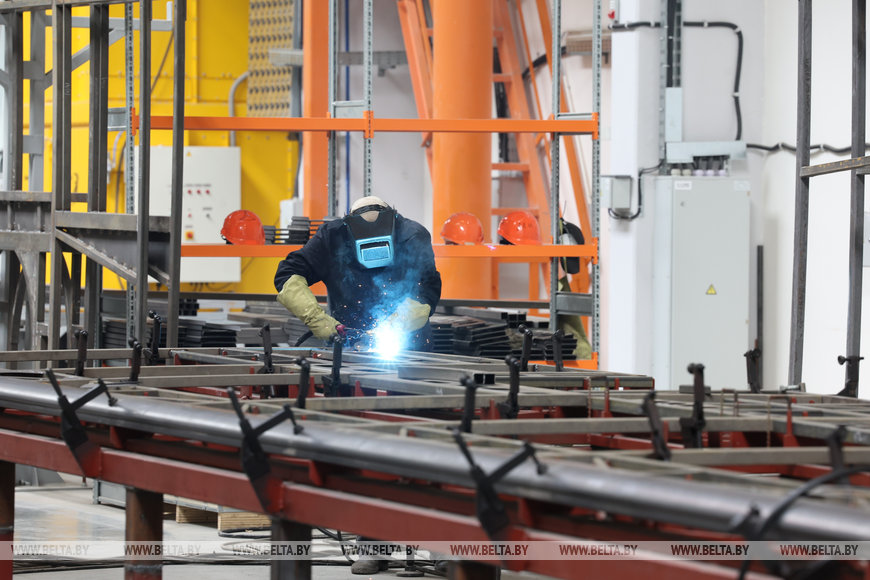
Today the whole technological cycle is under one roof. The new plant features welding, painting and assembly shops, a welding, blanking and mechanical workshop, diagnostics, adjustment and delivery garages, and storage facilities. The plant boasts three autonomous lines (previously there was only one) to simultaneously assemble buses of different models. It took a year and a half to build the site from scratch. The Minsk City Hall innovation fund supported the project. The total investment exceeded Br300 million.
Just estimate the scale: the area of the bus welding and assembly shop is over 32,000 square meters. This is eight football fields! The total area of the plant is more than 40,000 square meters.
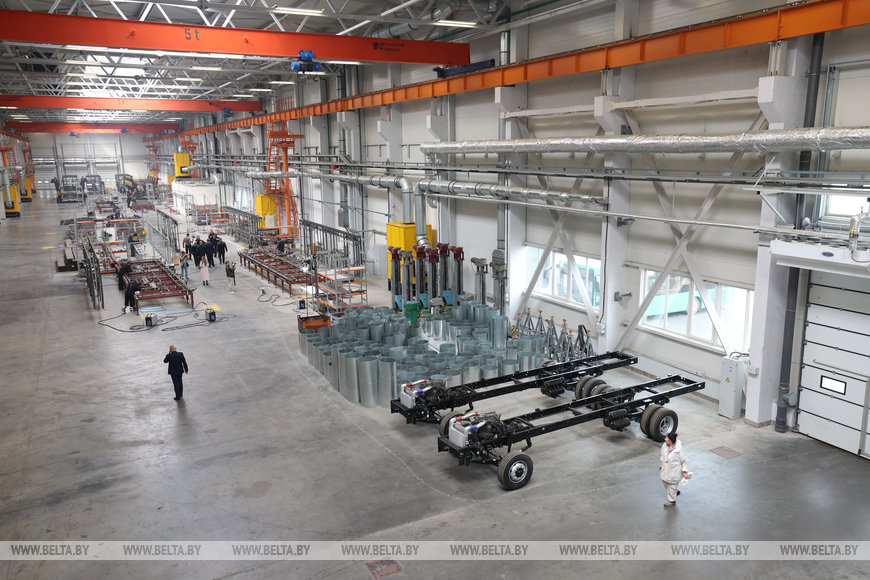
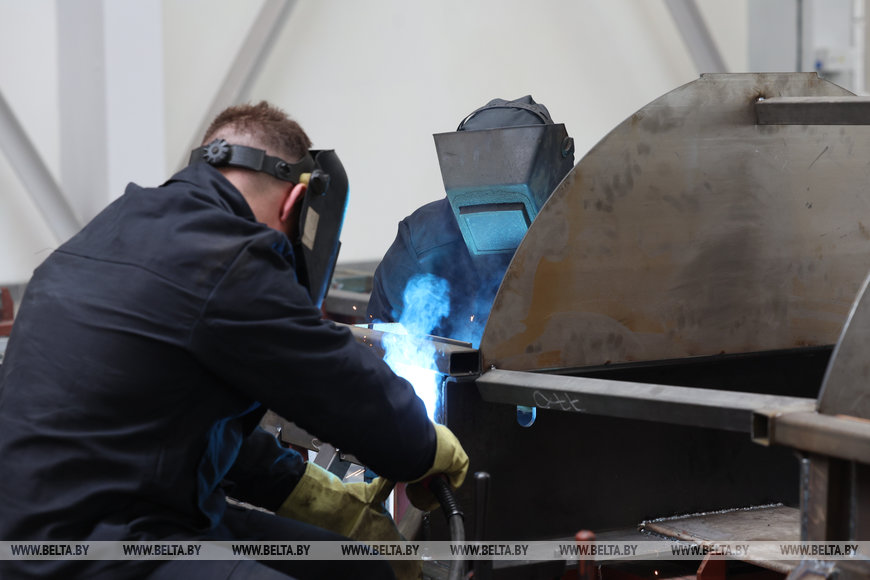
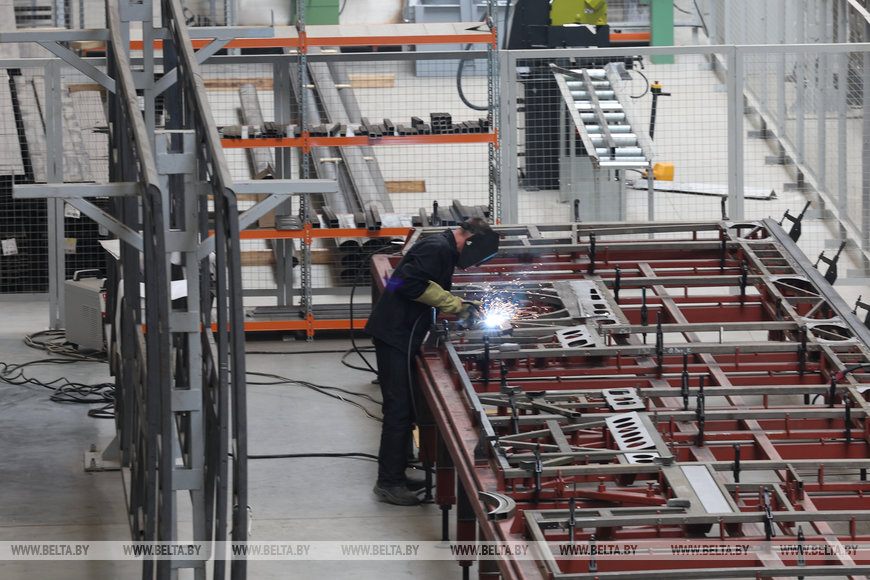
“Today the plant employs 350 specialists, who were transferred from these shops. Seventy-six specialists have been hired additionally. The total number should reach 900 people,” chief engineer of the bus plant Aleksandr Niskoromny said.
Electric and gas welder Iosif Atrashkevich has been working at the plant for two decades. He is happy to see the working conditions at the plant changing to the better: “We moved to the new plant not long ago. The impressions are very good. The ventilation is advanced here. There is a lot of light here. The room is much bigger which makes it efficient and comfortable to work here. Today we can produce more than we did at the old plant. It gives motivation to work. I think we will reach a good capacity and provide transport for everyone.”

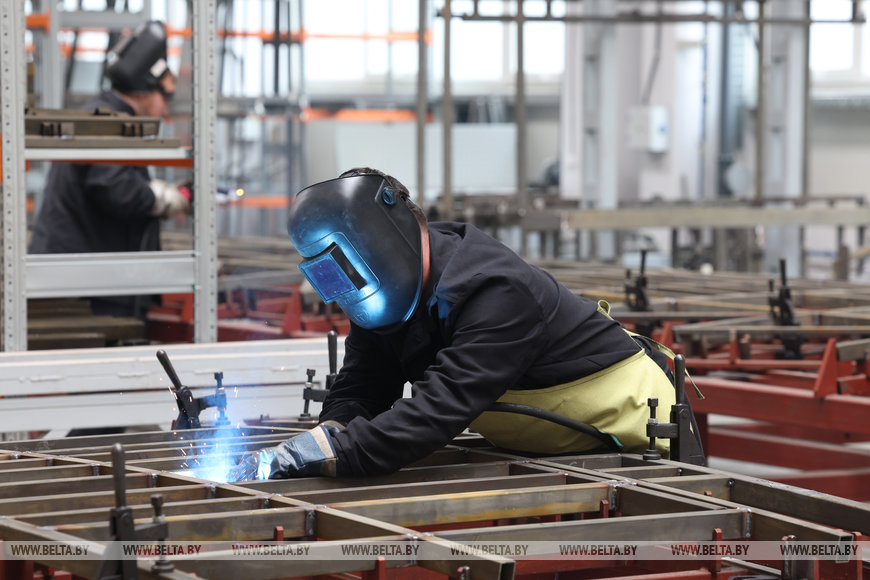
As far as the statistics are concerned, in recent years MAZ produced approximately 1,500-1,800 units of passenger vehicles annually. With the construction of the new facility, these figures will rise to 3,000 units per year, effectively doubling the output. The company emphasizes that the significance of this new production cannot be overstated, especially in the context of the global shift toward eco-friendly transport and stricter technical standards for passenger transport.
How Belarusian buses are made
The bus production process involves several stages: welding the frame, mounting, straightening and priming, installing the powertrain, assembling the body, applying filler and preparing for painting, automated painting and drying, and finally assembling the interior. After quality control, the finished passenger vehicles are handed over to the sales department.
As it was previously mentioned, this production process can be compared to aircraft manufacturing.



The reason lies in the fact that such equipment is not created on a conveyor belt or using robotic systems, as is common in car production. It is largely unique craftsmanship, essentially hand-made.
"Once all frame elements are welded together, the frame is sent to the main assembly fixture. When the base is set, the shutters are opened. The sides are leveled, and then closed. The frame is welded. After the bottom part is welded, the roof is added and welded, resulting in a complete bus frame," the chief engineer explained.



Why are robots not used in welding and other aspects of production? Aleksandr Niskoromny stressed that it is primarily impractical. For these technologies to pay off, the enterprise would need to manufacture at least 15,000 buses annually. For our country, and even for Russia, this is an unattainable figure. Meanwhile, China produces 150,000 buses per year. Another important factor is the wide model range at the enterprise, each with its own unique frame. Robots can't be programmed to handle this variety. If MAZ switched to producing a single model, it would be a different matter (again, assuming production of 15,000 buses annually). Moreover, manual welding allows for greater flexibility and faster adaptation of workshop operations depending on incoming orders.
"We have acquired an enormous painting complex. Now, we can paint up to six buses simultaneously, whereas previously, only one could be painted at a time. This facility features a cutting-edge ventilation system, significantly better lighting, efficient air purification, and high-quality compressed air preparation. It has become much more convenient to paint articulated buses, which previously did not fit into our smaller booths and had to be painted in sections. Now, they are fully painted in a single stage," Tatiana Shalai, senior specialist of the painting section shared.


After painting, the bus moves to the final assembly line, which spans a couple of hundred meters. One key aspect of this process is the bonding of glass windows. Glazed windows contribute up to 40% of the frame's rigidity.



"Depending on the model range, operations vary. For instance, assembling a mid-range bus requires approximately 1,000 standard hours, while assembling an intercity three-axle bus takes over 4,000 standard hours. This is why the three assembly lines ensure parallel and uninterrupted production," the factory workers stated.

Why do Belarusian companies hire labor migrants?
Due to the tense labor market conditions, MAZ had to resort to using foreign labor. The company has employed around 400-450 Uzbekistan’s citizens, who work at various facilities within the holding company.
"There is a shortage of personnel. Firstly, the demographic decline of the 1990s has had an impact. Secondly, young people are choosing other fields, such as IT. Vocational jobs are not in demand. However, we have launched a number of programs and are working with colleges and universities," the company noted.
MAZ is also ready to welcome specialists from Pakistan. This topic is widely discussed online today. The president even had to address this issue to clarify certain points, and his statements were quite definitive. "I emphasize once again, no matter how the situation develops, there must be order in our country. We should develop a mechanism, and it should be approved by our government and their government [reference to Pakistan], exercise tough control over migration and invite and employ those who want to work here," Aleksandr Lukashenko said during a recent meeting.
Business or social project?
“On behalf of our many-thousand team I would like to express our profound gratitude to our president for the decision to build the new bus plant. The production capacity is 3,000 passenger vehicles which is a serious economic effect and new jobs,” MAZ Director General Valery Ivankovich said.



According to him, the new bus plant is technological sovereignty in action. Not only of the enterprise, but of the country as a whole. “Now the task is to reach the optimal production capacity by 1 January 2026,” Valery Ivankovich added.
As with any project, the authorities expect the return on investment. The time framework has been outlined. But, on the other hand, does everything rest solely on money?
“When we get on a bus, we see pensioners, schoolchildren and students among passengers. Is this a business or a social project? Or when foreigners use the bus, they evaluate our country by the quality of the vehicle. Is this a business or a social project?” Valery Ivankovich asked a reasonable question.


It is estimated that by increasing efficiency and producing in-demand diesel, gas and electric vehicles, the added value per employee will range from €78,000 to €108,000. By 2027, the plant will assemble passenger vehicles of the second and third generations, and then switch to the production of buses of the third generation only.
“The launch of the new production facility marks an increase in capacity. It is also a qualitative leap in the development of Belarusian machine building. We are creating vehicles of the future, which will serve people in Belarus and abroad,” the company said.
What are the features of third-generation MAZ buses?
By the way, the first bus to roll off the assembly line will go to Mogilev Oblast. This is a fundamentally new model - the third-generation bus MAZ 303047.
Its main features are low floor (which makes it even more comfortable to board the bus), ergonomics of the interior, possibility to install up to 16 passenger seats without ramps under them, and an increased glazing area. The most important advantage is the universal frame. MAZ uses this body to produce different types of passenger vehicles running on diesel, compressed or liquefied gas and electric drive. This feature is not noticeable to the passenger's eye, but it is very important for customers.
Which countries use Belarusian buses?
“For the last five years we have been growing annually in terms of the output. Despite the fact that the new plant has come on stream just now. In 2020 we started with 1,300 vehicles. Last year we manufactured and sold almost 1,700 units. We don't have any inventory at all, we work to order. All the vehicles you saw in the workshop have already been sold,” said MAZ Deputy Commercial Director Vladimir Dormash.

The main markets are Belarus and Russia. But MAZ seeks to diversify and tap into new markets. Vladimir Dormash noted that this year MAZ will significantly increase deliveries to foreign countries


“We have agreements with a number of Asian countries, Latin America, Africa,” he said. In total, MAZ vehicles are now supplied to 50 countries.
Earlier this year, when visiting the new bus facility, Aleksandr Lukashenko recalled his last visit to MAZ. Back then, according to him, the working best conditions at the factory were not the best.
“You started designing and making buses and promoting their sale, especially in foreign markets. Good job! You deserve to have your own bus plant,” the head of state said at the time. “You will increase the output by around 2,000 every year, and then there will be no problems with work and employment not only for you, but also for your children.”


Preservation of the Belarusian industrial flagships was the main task of the president. As a very young leader of the country, he promised himself to preserve the legacy created by previous generations. The factories had to be saved and this story lasted for many years. But, you must agree, today, when we see our Belarusian vehicles humming along the streets of our cities and especially abroad, we feel proud of our homeland.
Aleksandr Lukashenko assures that the state will continue to support enterprises. In return they are expected to perform strongly and show results.






